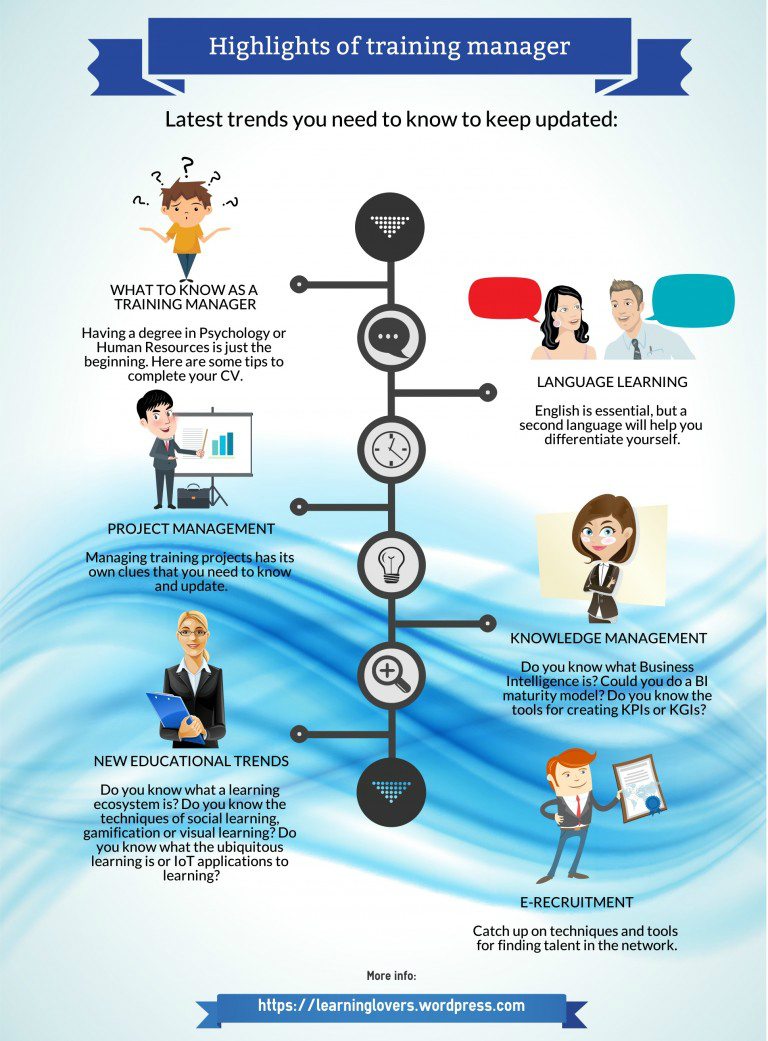What Should A Training Manager Know In The Company To Keep Up?
Recent college graduates in fields related to HR ask this question in order to improve their CV before getting in the labor market. But getting updated is not an easy task for people with a great work experience, passing one hundred percent of their working day (and beyond) busy in taking forward the urgent, no time for what's important: Updating their professional profile.
This article is a brief selection of areas of interest to a good professional in training management in the company, although there are certainly many more. We wanted to give importance to the necessary skills to face an increasingly global and in constant evolution market:
- Update your English skills.
Maintaining a phone conversation, a business discussion at a meeting with five people at a time, understanding the most diverse accents (native and other foreigners from non English-speaking countries) are increasingly frequent situations in a non-speaking company. Here are some free resources to “deoxidize” the ear:- British Council Resources.
- BBC Learning English.
- The simple English Wikipedia.
- Duolingo.
- Other resources.
- Submerge yourself in the management of training projects.
A person in charge of a training department has that be able to manage large projects for internal and external clients in the company: From the detection of customers’ training needs, consulting work, the elaboration of the proposal, the implementation of the project, planning, the formation of the team, monitoring, budgetary control, identification of the project milestones, compliance in time and form, the final report, customer feedback... He or she will offer services such as the development and teaching of courses, planning of training portals, management of Learning Management System, social learning platforms (peer to peer), elaboration of KPIs and a long etcetera. The technique of project management has its own particularities when applied to training. We have selected for you these free courses that teach you to seamlessly combine both factors:- MBA em Engenharia e Inovação.
- INEM 2015 Course: Advanced technician in project management for distance training.
- Free online course: Design of innovative educational ICT projects.
- Managing knowledge.
- Business Intelligence.
One of the tasks that affect the entire organization and that can be managed from the HR Department is the management of business intelligence. It is possible that in some companies this is also a task associated with the training area. Do you want to know what is it? Here are a few tools and tasks associated with knowledge management (collaborative business intelligence): First, it is recommended to take a BIMM or Business Intelligence Maturity Model to get to know the state of business intelligence in your business. This report will allow you to identify the starting point for defining the needs and future actions to be undertaken. To understand this concept, we suggest this reading:- BI maturity models.
Here you can find a list of academic papers related to maturity model business intelligence. Here you can find free online tools for the online model maturing business intelligence.
- BI maturity models.
- Performance management.
In relation to performance management, we recommend the following readings to understand its importance in the organization and the phases that this concept includes:- Gestión del Desempeño en Recursos humanos.
- La gestión del desempeño como una disciplina empresarial.
- To track the performance management, the HR department (and sometimes training managers) prepare reports as the Balanced Scorecard, KPIs (Key performance indicators) and KGIs (key global indicators). You can get to know more about the meaning of these terms here. To prepare KPIs, you can use tools of Open Source Business Intelligence (OSBI) as:
- Sharing knowledge.
As for the sharing of knowledge in the company, the training manager uses the internal and external communication tools available in the organization. Here we list some of them, with links of interest related to free online tools from which you will be able to manage them:- Intranet.
5 Free applications to create a corporate intranet. - Videoconferencing.
10 free online tools for videoconferencing. - Webchat.
- Intranet.
- Sharing of documents.
To foster intra and inter departmental collaboration, it is important to make available to employees all working tools that will allow them to work together on the same document, file sharing and publish and download private business information in a safe way. To do this, we suggest some free platforms to share documents in the cloud. - CMS (Content Management Systems).
Those are online tools to manage and edit corporate online content that are accessible to all employees or to a section of them. To understand the concept, we recommend Qué es un CMS and Wikipedia: Sistema de gestión de contenidos.- There are free software tools to manage content available on the internet.
- The transmission of information and promotion of corporate training both inside and outside the organization through the network pushed increasingly to the training manager to have notions of community manager, SEO, SEM, both to meet the online media on training, and to extract the most out and monitor and evaluate its performance. To understand the techniques of community management and monitoring with Google Analytics, we recommend: 25 free marketing online courses, New Free Solomarketing Community Manager course, and 8 free courses about online marketing and community manager to download.
- Business Intelligence.
Introducing New Trends On Training
With the incorporation of new technologies in training, classical learning methodologies have been adapted, transformed into new models and learning strategies. Here are some of the latest trends in companies:
- Training ecosystems in the company and personal learning environments.
Large companies are developing so-called ecosystem of training, large structures that store, distribute, share and allow participation in the global knowledge of the entity by all employees, at different levels of depth and access. We recommend these readings to know them better: - Social learning.
Social learning is based on the idea of sharing knowledge and building peer-learning, so that different participants in the process not only receive information and training in a passive way, but participate with their experience and knowledge and collaborate in the construction of a common learning built between all those involved. This concept is supported in the Social Learning Theory. To learn more about social learning, we recommend: What is Social Learning? - Visual thinking.
Visual thinking is based on the visual presentation of knowledge, so that the concepts are selected, sorted, structured into categories and presented through images, icons or symbols accompanied by short texts. - Practical learning.
"Learning by doing", "problem-solving learning", and "project-based learning" are some of the trends used in learning supported in practice. To know them better, we recommend: - Blended learning.
Blended learning is a blended training. The course combines hours of online training in the theory and classroom lessons where what has been learned is applied in a practical way to further acquire the skills. The tutor goes from being a mere transmitter of information to be a guide that encourages learning built by students, both individually and in groups. - Applying IoT to learning.
IoT is the acronym for Internet of Things. It involves connecting objects from everyday life to the Internet for sending and receiving data without human intervention (a refrigerator that sends a message to the supermarket when the milk is finished, a lighting system that turns on the light when it detects your presence in the room and keep a record of monthly consumption, a light that only turns red when it detects traffic on the crossing street, etc). In the following links you will find applications and information concerning the application of Internet of Things to learning: - 3D printing applied to learning.
From the recreation of body parts in 3D supplies, mechanical parts reconstruction or restoration of parts of objects or the production of scale models, 3D printing is taking its first steps to stay. Applications in the field of training have yet to be explored. Find out more here. - Gamification.
It involves the application of techniques and mechanics of game to issues or processes that usually have no relationship with it. The application of scoring, climbing levels of increasing difficulty, monitoring, pursuing an achievement in competition with others, obtaining rewards every step of the process or partial control of the situation by the participant are just some of its keys. To learn more, see here. - Ubiquitous Learning.
It consist on training at the right time and the right place without the presence of students in the classroom and in touch with their tutor and other students. We invite you to see the complete definition in the following links: Wikipedia: Aprendizaje ubicuo, EduTech Wiki: Ubiquitous learning.
Promoting Coaching And Mentoring
Although this aspect is already beginning to be a classic in talent management, we have included it in our selection because it is a realistic and practical way to add value to people in the organization and create a spirit of collaboration and development in team works, so needed at the training area. You can find information about coaching and mentoring and development methodologies applied in organizations here.
Researching The Market Of Talent With e-Recruitment Tools
Although the selection of people is an area of HR, sometimes the person responsible for training in an organization have to assist in the task of selecting talent, as well as on the initial training for newcomers for them to understand the operation, mission, and vision of the organization, the internal policies of corporate social responsibility and their specific responsibilities and functions within the organization. Below are some links that will help you better understand the application of new technologies in the process of recruitment:
- The definition of e-recruitment: Wikipedia: e-Recruitment, What is e-recruitment?
- An explanation of existing screening techniques in the network is available at: Recruitment 2.0 - Social Networks, Techniques And Methods To Find Talent In Network: Webinar.
- Some free tools to use in online recruitment: Get trained in recruitment through LinkedIn, Facebook, and others through free courses. Also learn how to use YouTube, and Twitter for online recruitment. Finally, for Twitter, check this: Can Twitter open up a new space for learning, teaching, and thinking?
- Recruitment Meetups: Los grupos Meetup de Reclutamiento más grandes del mundo.
Conclusion
As we have seen, the task for knowledge management, talent, and training in the organization is not simple, and we must be prepared for the latest trends that are being incorporated and that modifies earlier forms of doing in its path. Above all, our recommendation is to stay updated, with an open and flexible mind capable to adapt to change, to learn quickly to acquire new knowledge and skills and to work openly with others in sharing knowledge. Good luck in your work!
Did you find this content interesting? Share it! Want to make a suggestion for updating? Use the space for comments to help us improve. Have you met any of these at your job and you were surprised not knowing how to deal with the new situation? Tell us your experience! Your opinion is interesting for us.








